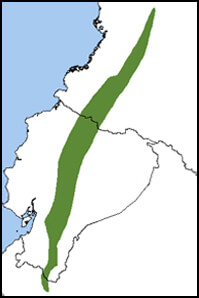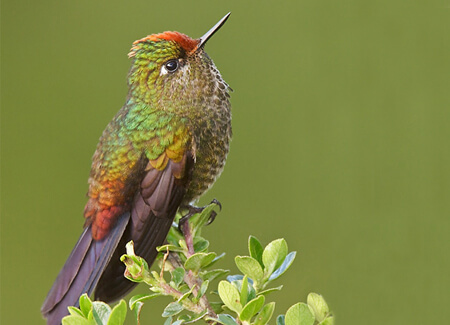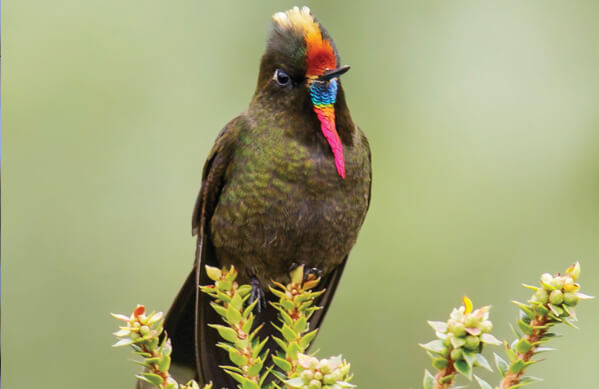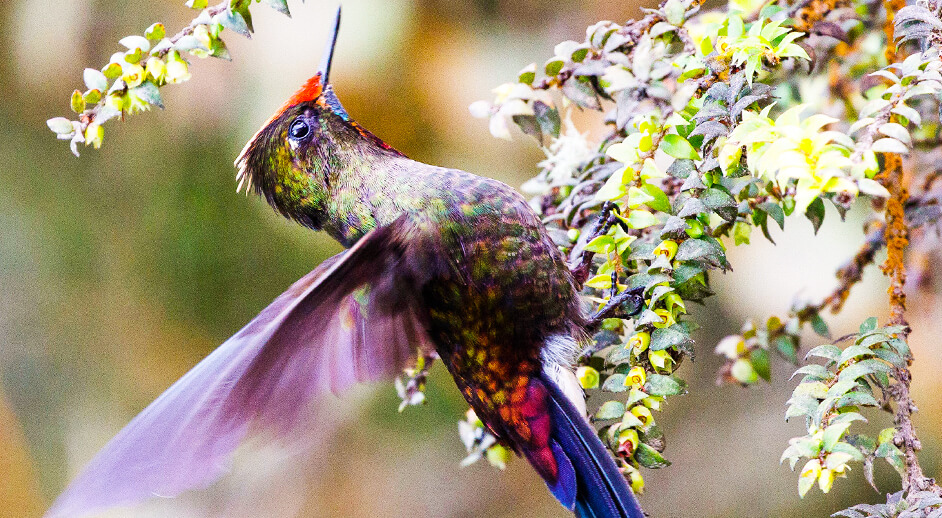 At first glance, the Rainbow-bearded Thornbill seems notable only for its short, dark bill; bold, white tail corners; and rufous forehead and crown. But seen in good lighting, the male's elongated gorget flares into a glittering cascade of bright colors.
At first glance, the Rainbow-bearded Thornbill seems notable only for its short, dark bill; bold, white tail corners; and rufous forehead and crown. But seen in good lighting, the male's elongated gorget flares into a glittering cascade of bright colors.
This remarkable hummingbird shows a number of adaptations for living at higher altitudes. Unfortunately, it is considered uncommon throughout its range, with a declining population blamed on habitat loss, a threat that affects other Andean hummingbirds, including the Long-tailed Sylph and Glittering Starfrontlet.
These hummers favor well-drained, rocky slopes below the tree line, where they may be spotted quietly feeding atop low shrubs or close to ground level, occasionally even landing on the ground for a short time. They are thought to make seasonal movements between different elevations, a phenomenon known as altitudinal migration.
High-altitude Adaptations
Rainbow-bearded Thornbills have short, straight, “thumbtack” bills that allow efficient feeding from the small but numerous flowers available in their high-altitude habitat. Their short bills also act as useful probes for gleaning insects from flowers, foliage, and bark; the hummingbirds then flick their insect prey into the air before snapping it up. This species feeds heavily on small insects when nectar is scarce–another useful adaptation to its extreme environment.
These hummingbirds have relatively large bodies, and conserve energy in the thin mountain air by clinging to flowers while sipping nectar instead of hovering. Relatively long, strong legs and feet allow them to hop from plant to plant or even on the ground, rather than use energy by flying.
Sign up for ABC's eNews to learn how you can help protect birds

Female Rainbow-bearded Thornbill, Glenn Bartley
Coping with the Cold
Since nighttime temperatures in the Rainbow-bearded Thornbill's habitat can plunge below freezing, nesting females build thick-walled, well-insulated nests, often placed in a niche on a cliff face, hidden behind hanging vines or other vegetation.
Rainbow-bearded Thornbills, along with many other hummingbirds such as Violet-crowned Hummingbird and Costa's Hummingbird, survive cold nights by entering a nightly hibernation called torpor, where their body temperature, breathing, and heart rate drastically slow. By sleeping in this way, hummingbirds can save up to 60 percent of their available energy.
Trolling for Thornbills
Although the Rainbow-bearded Thornbill does not reliably visit feeders, it can sometimes be seen in the open, shrubby habitat next to the trails of Ecuador's Yanacocha Reserve, where birders may also spot the closely related Purple-mantled Thornbill or the Critically Endangered Black-breasted Puffleg. Visitors can also spot the Rainbow-bearded Thornbill at the Tapichalaca Reserve, along with other rare species such as the Jocotoco Antpitta and Golden-plumed Parakeet. Both of these reserves are supported by ABC and managed by in-country partner Fundación Jocotoco.
Donate to support ABC's conservation mission!




















































